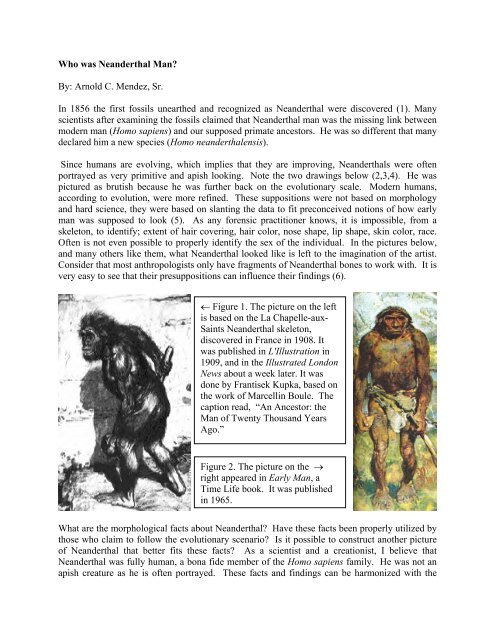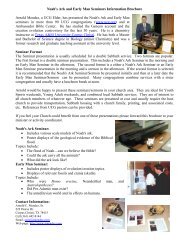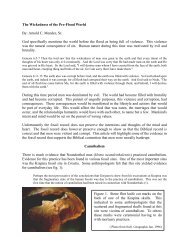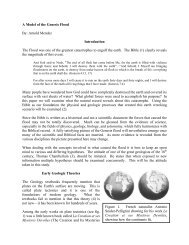Who was Neanderthal Man? - Noah's Ark & Early Man
Who was Neanderthal Man? - Noah's Ark & Early Man
Who was Neanderthal Man? - Noah's Ark & Early Man
- No tags were found...
You also want an ePaper? Increase the reach of your titles
YUMPU automatically turns print PDFs into web optimized ePapers that Google loves.
Mendez 5Noah’s flood <strong>was</strong> a major catastrophe that affected the earth. As has already been shown thesefactors affected all of the earth’s ecological system. These changes in the ecological systemaffected the physiological systems of the humans that lived on the earth. Most modern daygeologist and evolutionist do not fully comprehend the ramifications of the flood. The vastmajority of these scientists follow the uniformitarianism principle as it relates to the events of theearth’s prehistory. They believe that the “present is the key to the past.” They will only acceptas possible what is happening today. Since there are no earth wide floods occurring now therehave never been any in the past. They have blinded their eyes to divine revelation. Since no onecan prove with certainty what has happened in the past they refuse to consider any other positionexcept their own. My assertion is that the earth’s geologic structures and the biological systemthat we see in operation today can be fully explained in the context of Biblical revelation.What were some of the physiological and environmental factors that produced <strong>Neanderthal</strong>?Before we address this topic certain groundwork must be laid. As humans we tend to viewthings from our own perspective. We consider it normal to die at about 72 years of age. Weconsider it normal to be in a constant state of battle with various debilitating diseases. Weconsider it normal to age the way we do. We consider it normal to go through puberty in ourteenage years and be married in our twenties. We consider it normal to retire at 65 because ourbodies are too old to continue to function. We consider all these things normal because this isthe only way of life that we have know.But consider the facts as outlined in the Bible. Think about how different life would be if we hadlived in the world before the flood. What if it <strong>was</strong> normal to have good health? What if it <strong>was</strong>normal to eat foods that actually helped retard or slow the aging process? What if it <strong>was</strong> normalto go through puberty at 30 – 40 years of age? What if it <strong>was</strong> normal to be able to live 500 +years? What if it <strong>was</strong> normal to be able to conceive and bear children at the age of 100, or 200,or 300? What if the characteristic of <strong>Neanderthal</strong> morphology were normal? What if it werenormal to have a bigger brain than you have now? What if it were normal to have a bonestructure that <strong>was</strong> 20 –25% more dense than you have now? What if it were normal to have awell-muscled and healthy body? A body that could do massive amounts of physical work and dothis type of work for centuries.Figure 8. Compare thesepictures of <strong>Neanderthal</strong>with fig 1 & 2. Recentresearch has shown that<strong>Neanderthal</strong> <strong>was</strong> a verymodern lookingindividual. He <strong>was</strong> wellmuscled, extremelystrong, and had a welldeveloped skeleton. Healso had all the culturalattributes of modern man.These drawings are the workof scientific illustrator JayMatternes, from the Octoberissue of Science 81.
Mendez 6What I am proposing is that we need to completely change our thinking about <strong>Neanderthal</strong> man.I propose that he is normal and we, modern day humans, are abnormal. If this is true, then in factwe have been devolving. We are on a downward path as a species. This goes contrary to thetheory of evolution, but it fits nicely within the framework of biblical knowledge about ourancestry and our current path as a society.<strong>Neanderthal</strong> MorphologyWhat would happen to a human baby that <strong>was</strong> born into the antediluvian world? Would it ageand develop the way babies do today? My contention is that the <strong>Neanderthal</strong> characteristicswere a physiological response to a human being living under the conditions as described in theearly chapters of Genesis. There are several factors that we need to examine in our explanationof <strong>Neanderthal</strong>’s unique morphology.<strong>Neanderthal</strong> man <strong>was</strong> a direct descendant of Adam. He <strong>was</strong> therefore closer to the creation thanwe are. Adam and Eve did not suffer from genetic loading. Genetic loading is the devolution ofour genetic material via mutations and alterations in our chromosomes. The Bible states thatafter Adam and Eve were created that God pronounced his creation very good. (Gen. 6:31)Adam and Eve had perfect genetics. They would not suffer from many of the genetic diseasesthat we have today because of genetic imperfection. After Adam and Eve sinned then death anddecay <strong>was</strong> projected into the picture. The question is often asked where did Adam descendantget their spouses. The answer is that they intermarried among themselves. This would not havecaused any physical problems because there would have been no genetic loading. When amutation occurs in the genetic material it is usually recessive. In other word it does not manifestitself unless it is matched with another recessive gene from the other parent. Adam’s closerdescendants did not have these mutated recessive genes. Abraham married his half-sister. Thiscaused no genetic problems. As mankind progressed (devolved in reality), then God had toinstitute marriage laws. By this time humanity had built up a number of genetic mutations andmarriage among close relatives would have caused defects and diseases.What caused these genetic mutations? <strong>Man</strong>y factors cause mutations. Some include ionizingradiation, non-ionizing radiation and chemical carcinogens (19). Atmospheric radiation reachesus from the sun and some naturally occurs in the rocks of the earth. Carcinogen are eaten,absorbed, or breathed.What could have lessened the formation of mutations in the past? There are many theories. Oneconcerns atmospheric and magnetic changes. According to the proponents of this scenario anincrease in the strength of the earth's magnetic field, through its increased shielding effect, wouldhave kept excessive solar radiation from entering the earth’s atmosphere. This solar radiationhas been implicated in many chromosomal mutations. But the sun is not the only source ofradiation. The rocks of the earth give off natural radiation. Radon-222 (Radon for short) is aradioactive decay product of uranium-238 and radum-226. Radon has been shown to causecancer in humans. Much radioactive rock is buried below the surface of the earth. The flood ofNoah cause large-scale massive tectonic activity. There were great earthquakes and volcanoes.This brought the deeply buried radioactive elements to the surface of the earth. After the floodthere <strong>was</strong> an increase in the background radiation both from the sun and the new volcanic
Mendez 7deposits. It is interesting to note that the life span of the people mentioned in the Bible droppeddramatically after the flood. This would have been caused by the increase in the geneticmalformations, which were linked to the atmospheric and geologic radiation.Let us now turn our attention to carcinogens. Carcinogens are chemicals that we are expose tothat cause cancer. In the pre-flood world the transport of carcinogens would have occurred at adifferent rate. The book of Genesis states that the earth at this time did not have a rainevaporationcycle. All of the moisture <strong>was</strong> deposited by a dew process (Gen. 2:6). This wouldretard the spread of any chemical. These carcinogens would not have a transport mechanism andwould therefore remain outside of the diet of the people before the flood. Only in recent times,when chemicals have been concentrated and become widespread, has the carcinogenic effect ofchemicals been noted. After the flood the meteorological conditions of the earth changed. Rain<strong>was</strong> now a transport mechanism. This allowed man to ingest more chemicals and trace elementthan before. These newly ingested carcinogens would have had affects on the rates of cancer anddisease. It would also have shortened the life span of people after the flood.These shortened life spans would have cause vast morphological changes in human and animalanatomical systems as compared to organism that lived longer. Once again we must considerthat God’s intention <strong>was</strong> for humans to live a long time. We are living in a cursed world. Godpronounced a curse on the earth (Gen. 3:17; 5:29). This cursing of the earth affected theproduction of increased solar and ground radiation, carcinogens, hostile environmentalconditions, a change in fauna and therefore lessened nutrition, less oxygen and reducedatmospheric pressure. All of these factors tended to lessen the life span of post diluviummankind.Long-lived <strong>Neanderthal</strong>sLittle research has been done on the effects of aging, above the 120-year level, on the humananatomy. The reason is obvious. This is the upper limit for present day humans. The reasonthat limited research has been done on this field is the constraints placed on scientist by theuniformitarian philosophy. Since humans do not live past 120 years today, they certainly did notlive any longer in the past. The question still remains what would happen to a child born into thepre-flood world when the life expectancy <strong>was</strong> in the hundreds of years? Would not theenvironmental factors extant at that time affect his growth and development? We would notexpect to see changes in human’s morphology.Much scientific literature addresses the subject of skeletal and cranial shape changes that wouldoccur as a person aged. (20,21,22,23). This research presents a convincing case that accounts forthe unique <strong>Neanderthal</strong> morphology to the cranium and skeletal features. The main thrust of thisresearch states that as humans age, the skull flattens, it becomes wider, and it lengthens. Thepronounced brow ridges can be accounted for by the long term and greater pressure that the<strong>Neanderthal</strong> chewing would place on the teeth and face (24). Since the <strong>Neanderthal</strong>s were moremuscular and heavier boned, the brow ridges would become more pronounced in order to allowthe greater stress to be absorbed. All of these features would occur to modern man if he livedlonger and had a heavier musculature (25). In other words, <strong>Neanderthal</strong> unique cranial featureswere a result of non-evolutionary factors.
Mendez 8Another factor to consider is the nutritional factor. Some <strong>Neanderthal</strong> skeletons exhibit skeletalchanges that are consistent with rickets. Rickets is a vitamin D deficiency. The body’s skintissue produces vitamin D when the body is exposed to ultraviolet sunlight. People that do nothave the proper amount of vitamin D develop rickets, which is a bending and thickening of someof the skeletal bones. The <strong>Neanderthal</strong> population lived during the Pleistocene Epoch,sometimes called the ice ages. They would spend most of their time in caves. They would tendto wear fur clothing, which covered most of the skin. All of these factors would not allowenough exposure to the sun and would therefore produce rickets. The first <strong>Neanderthal</strong> skeletonsthat were analyzed all show features characteristic with rickets (26). Once again this is a nonevolutionaryexplanation for <strong>Neanderthal</strong> features.Conclusion<strong>Neanderthal</strong> man <strong>was</strong> a direct descendant of Adam and Eve. He <strong>was</strong> fully human and <strong>was</strong> aproduct of his environment. <strong>Neanderthal</strong>s were larger brained, more muscular, extremely strong,and longer-lived than modern man. We must not let our preconceived notions about supposedprehistoric men cloud our picture of the proper understanding of <strong>Neanderthal</strong> man. Only whenwe consider all the facts can we see the complete picture.<strong>Neanderthal</strong> man <strong>was</strong> not a product of evolution. All of the evidence properly understoodsupports the Genesis account of early man as described in the Bible.© Arnold C. Mendez, Sr. & Mendez EnterprisesEmail: acm@amendez.comWebsite: www.amendez.com
Mendez 9Works Cited—Research Notes1. In reality <strong>Neanderthal</strong> fossils were discovered earlier but their importance <strong>was</strong> not recognizedand they have remained out of the mainstream of research.2. Kupka, F. Illustrated London News. 1909.3. Kupka, F. L'Illustration.1909.4. Howell, F. Clark. <strong>Early</strong> <strong>Man</strong>. Time Life Inc. New York NY. 1965.5. Szpir, M. Nasty, Brutish and Short? American Scientist. 81:328-29, 1993.6. Marcellin Boule's reconstruction of the La Chapelle-aux-Saints <strong>Neanderthal</strong> skeleton <strong>was</strong> verybiased. This evaluation <strong>was</strong> done at the turn of the century when Darwin's theory had come toacceptance by most of academia. it <strong>was</strong> expected that fossil men would be more primitive andtherefore they were interpreted as such. In the book Guide to Fossil <strong>Man</strong> by M. H. Day, anevaluation of Boule's evaluation, quoted below, is given on page34. Day <strong>was</strong> overly diplomaticin his assessment of the situation.In view of the features of the post-cranial skeleton, Boule suggested that the stance of La Chapelle man(Neandertal man) <strong>was</strong> stooping with flexed hips and knees and jutting head carriage, and his undoubtedlybipedal gait imperfect and slouching. Examination of the skeleton (Arambourg, 1955: Cave and Straus,1957; Patte, 1955, Dastugue and de Lumley 1976) has shown that there is evidence of gross deformingosteoarthritis present in the specimen and that Boule's reconstruction is faulty in a number of respects. Thereasoning behind Boule's conclusion concerning the stance and gait of the La Chapelle <strong>Man</strong>, as well as hisconclusion that the Neandertalers represent an extinct side branch, has been explained by Hammond(1982). He advances the view that these conclusions owe more to preconceived notions than to adispassionate anatomical appraisal. Comparison with other Neandertal remains and a wider range ofmodern skeletal material has shown that many of the features recognized as being characteristicallyNeandertal fall within the range of modern human skeletal variation. Whilst Cave and Strauss (1957) do notdeny the distinctive morphological characters of Neandertal man, they suggest that he stood and walked asdoes modern man.A full re-evaluation of the La Chapelle skeleton has suggested that, whilst this individual did indeed suffer fromdegenerative joint disease, Boule's faulty postural reconstruction <strong>was</strong> not affected by the presence of this condition(Trinkaus, 1985)7. Although most estimates of <strong>Neanderthal</strong> place him about 5'4"-5'8". Some skeletons of earlierman show them to be over six feet tall. A Homo erectus (supposed earlier ancestor of modernman and earlier than <strong>Neanderthal</strong>) skeleton of a teenage boy <strong>was</strong> discovered. It <strong>was</strong> estimatedthat he would have been six feet tall at maturity. See the following:Brown F. Harris J. Leakey R. Walker A. <strong>Early</strong> Homo erectus skeleton from west Lake Turkana,Kenya. Nature. 316:788. 1985.8. Tattersall, I. The Last <strong>Neanderthal</strong>. Macmillan. New York NY. 1999.
Mendez 109. Trinkaus E. The <strong>Neanderthal</strong>s. Scientific American. 118-33. December 1979.10. Trinkaus, E. Hard Times among the <strong>Neanderthal</strong>s. Natural History. 87:10, 1978.11. Geist, V. <strong>Neanderthal</strong> the Hunter. Natural History. 90:1:30, 1981.12. Lubenow, Marvin. Bones of Contention. Baker Books. Grand Rapids, MI. 1992.13. Day, M. Guide to Fossil <strong>Man</strong> 4 th ed. University of Chicago Press. Chicago, IL. 1993.14. Appenzeller, T. 1998. Evolution or Revolution. Science. 282: (20 November 1998) 5393.15 . Stacey FD. Electrical resistivity of the earth's core. Earth and Planetary Science Letters.3:204-06. 1967.16. Patten, DW. The Biblical Flood and the Ice Epoch. Pacific Meridian Pub. Seattle, WA.1966.17. Oard, MJ. An Ice Age caused by the Genesis Flood. Institute for Creation Research. ElCajon, CA. 1990.18. Matternes J. Science. October, 1981.19. Burns, GW. The Science of Genetic. Macmillan Publishing Co. New York, NY.p.371,1989.20. Susanne C. Individual age changes of the morphological characteristics. Journal of HumanEvolution. 6:181-89. 1977.21. Israel H. The dichotomus pattern of craniofacial expansion during aging. American Journalof Anthropology. 47:47-52. 1977.22. Lasker GW. The age factor in bodily measurements of adult male and female Mexicans.Human Biology. 25:1:50-63, 1953.23. Cuozzo, Jack. Buried Alive: the Startling Truth about <strong>Neanderthal</strong> <strong>Man</strong>. Master Books.Green Forest, AZ. 1999.24. Endo B. Analysis of Stresses around the orbit due to masseter and temporalis musclesrespectively. Journal of Anthropological Society Nippon. 78:4:251-66. 1970.25. Frohlich B. Pedersen PO. Secular changes within arctic and sub-arctic populations: a studyof 632 human mandibles from the Aleutian island, Alaska and Greenland. Arctic MedicalResearch. 51:173-88. 1992.26. Ivanhoe, F. Was Virchow Right about <strong>Neanderthal</strong>? Nature. 227:578, 1970.






